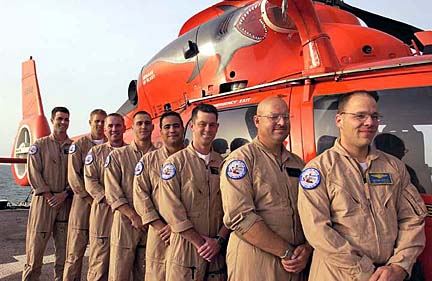
COAST GUARD PHOTO BY TOM SPERDUTO
Lt. Greg Fuller, left, Lt. Olav Saboe, Petty Officer Dave Blowers, Petty Officer Drew Dazzo, Petty Officer Harold Toledo, Lt. Cmdr. Tim Schang, Chief Petty Officer Russ Hoover and Petty Officer Mischa Gorsh pose before their HH-65 Dolphin helicopter while on deployment in the Persian Gulf.
Students’ notes buoy
Coast Guard crew
The Coast Guard crewmembers of an HH-65 Dolphin helicopter from Barbers Point say they were touched by the cards and letters of support and pictures sent by Iliahi Elementary School in Wahiawa while they patrolled the Persian Gulf.
"We ended up passing them around the ship," said Lt. Olav Saboe, 29, who recently returned from a 5 1/2 month deployment as a pilot of the twin-engine Dolphin that was assigned to the Coast Guard cutter Boutwell, which is from Alameida, Calif.
For nearly four months beginning in January, the Boutwell was assigned to the USS Tarawa battle group, whose mission at that time was to enforce the United Nations sanctions against Iraq.
"When the war started around March 20, the cutter's mission was to protect the fleet," said Saboe, who has been flying helicopters with the Coast Guard for five years.
"We also supported the protection of two of the world's largest oil rigs, which are located 15 miles off the coast of Iraq near its border with Iran," he said.
Saboe said each oil rig was a mile long.
"The Republican Guard had orders to blow them once the coalition forces started to advance on Iraq," Saboe said. "But Navy SEALs were able to get in early and secured both rigs. The Coast Guard then sent in a reserve unit to guard them."
Saboe said his unit's other major mission was to provide aerial escorts for ships with cargos of humanitarian aid moving up the Khwar Abd Allah River, which separates Kuwait and Iraq.
Saboe pointed out that this was the river where the Coast Guard buoy tender Walnut, from Sand Island, was in charge of marking a clear passageway on the 40-mile waterway by retrieving and modifying 35 buoys.
"Getting this humanitarian aid was critical for people of Iraq and the world," he said. "It was important to get food flowing into that port so coalition forces could get them into the country."
Coast Guard patrol boats were assigned to the front and end of the convoy of ships.
"Our job was to ensure that there were no mines, vessels, swimmers or anything else that could cause a problem," Saboe said.
His crew never came under fire, "because coalition forces had full rein of the air space, although there were always the threat of surface-to-air missiles," he said. "That was one of our constant worries, but fortunately we didn't see any of that."
However, when cutter Boutwell was patrolling waters near Iran, it was challenged by Iranian gunboats.
"We were launched to identify the vessels, and because we didn't want to provoke hostilities with the Iranians, we backed off," Saboe said. "This happened twice."
He said Coast Guard cutters and helicopters were used to patrol that area because the cutters are white and their helicopters are orange, which distinguishes them from the Navy's gray warships and helicopters.
The bigger threats were natural ones, like fierce sandstorms.
"A couple of times they would sneak up on you, and then visibility was one-sixteenth of a mile," Saboe said. "There was one instance when we were working the (carrier) Abraham Lincoln, and although we had a good fix on it on radar, we didn't actually see it until were only a quarter of a mile away.
"And there is nothing bigger than a nuclear carrier in the Gulf."
Saboe added: "For the maintenance guys in our group, it was a constant battle. We were constantly monitoring the condition of the aircraft, washing it down whenever we could. Sand is no friend to moving parts."
The Barbers Point Coast Guard Air Station's eight-man detachment also provided support for the Lincoln, Constellation and Kitty Hawk carrier battle groups by moving people, parts and mail.
Saboe estimated his crew flew 188 sorties, or missions, with 91 of them being combat flights.
"It was definitely not a normal deployment," said Saboe, noting the cutters and other vessels from Sand Island are at sea for normally only two months.
"We had a pretty small part in the grand scheme of things," Saboe said after returning to Barbers Point on June 25. "We worked hard. ... It was always challenging and changing, but that is what we thrive on."
What helped, he added, was "the overwhelming support we got from all over the country, especially from home," like the cards and messages from the students at Iliahi.
"They had questions like if we were scared, or if we missed home, or what was it like flying in a sandstorm, or had we seen Saddam," Saboe said. "Most of all, they expressed their gratitude for what we were doing, and that was very touching."
